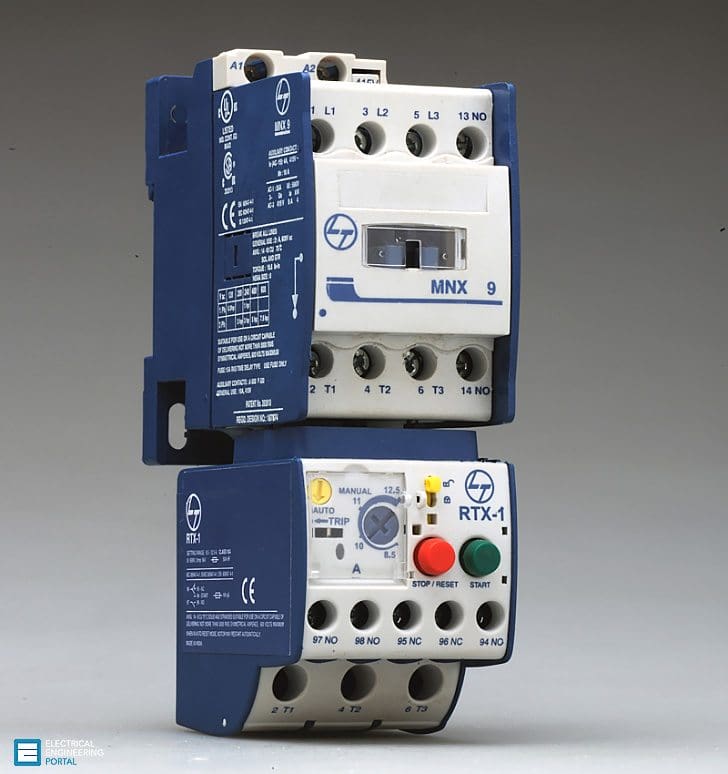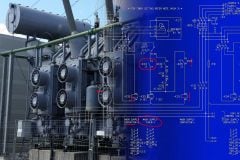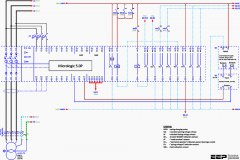Winding failures in motor
The majority of winding failures in motor are either indirectly or directly caused by overloading (either prolonged or cyclic), operation on unbalanced supply voltage, or single phasing, which all lead through excessive heating to the deterioration of the winding insulation until an electrical fault occurs.

The generally accepted rule is that insulation life is halved for each 10° C rise in temperature above the rated value, modified by the length of time spent at the higher temperature. As an electrical machine has a relatively large heat storage capacity, it follows that infrequent overloads of short duration may not adversely affect the machine.
However, sustained overloads of only a few percent may result in premature ageing and insulation failure. Furthermore, the thermal withstand capability of the motor is affected by heating in the winding prior to a fault.
It is therefore important that the relay characteristic takes account of the extremes of zero and full-load pre-fault current known respectively as the ‘Cold‘ and ‘Hot‘ conditions.
A generic mathematical model that is accurate is therefore impossible to create. However, it is possible to develop an approximate model if it is assumed that the motor is a homogeneous body, creating and dissipating heat at a rate proportional to temperature rise.
This is the principle behind the ‘thermal replica’ model of a motor used for overload protection.
The temperature T at any instant is given by:
![]()
where:
Tmax = final steady state temperature
τ = heating time constant
Temperature rise is proportional to the current squared:
![]()
where:
IR = current which, if flowing continuously, produces temperature Tmax in the motor
Therefore, it can be shown that, for any overload current I, the permissible time t for this current to flow is:

Therefore, the thermal replica should take into account both of these components, a typical equation for the equivalent current being:
![]()
where:
I1 = positive sequence current
I2 = negative sequence current
and
![]()
at rated speed. A typical value of K is 3.
Finally, the thermal replica model needs to take into account the fact that the motor will tend to cool down during periods of light load, and the initial state of the motor. The motor will have a cooling time constant τr, that defines the rate of cooling.
Hence, the final thermal model can be expressed as followin Equation 1:
![]()
where:
τ = heating time constant
k = Ieq / Ith
A2 = initial state of motor (cold or hot)
Ith =thermal setting current
Equation 1 takes into account the ‘cold’ and ‘hot’ characteristics defined in IEC 60255, part 8.
Some relays may use a dual slope characteristic for the heating time constant, and hence two values of the heating time constant are required. Switching between the two values takes place at a pre-defined motor current. This may be used to obtain better tripping performance during starting on motors that use a star-delta starter. During starting, the motor windings carry full line current, while in the ‘run’ condition, they carry only 57% of the current seen by the relay.
Similarly, when the motor is disconnected from the supply, the heating time constant τ is set equal to the cooling time constant τr.
Since the relay should ideally be matched to the protected motor and be capable of close sustained overload protection, a wide range of relay adjustment is desirable together with good accuracy and low thermal overshoot.
Typical relay setting curves are shown in Figure 1.

Resource: Network, Protection & Automation Guide – Areva











can anyone guide as to when to use co-ordination tables without overload relay and with overload relay?
Question: vent fan motor in high temperature area +90c AB manual motor starter with type P overloads. In same area at same temperature. Do you have to apply any sort of correction factor for the current for p overload selection. Assume 2.4 A.
Sir ,
please describe cold low & cold high and hot low & hot high in Over load tripping characteristic’s .
SIR
what is about dc motor protection?
could you give me information about dc motor protection?
thank you
Please provide more detail for thermal protection relay (49 relay of motor protection)
Hi
Is that formula valid for all motor ratings, for example 5.5kV/2.5MW motor ?
SIR
In our factory man cooler fans running at 24×7 so that bearing & winding issue happening at frequent,to avoid the winding failure ,can I put the relay in fan like mixy….
Eep website very useful to study and know about total electrical subject.
can you please tell me once the motor getting heat motor IR value what will happen?
Hai, can I ask a question here?
I found a single line diagram, overload setting @ current/voltage module is 63A…630A.
Breaker is 250AF/250AT
Load is 15.75kW
****************************************************
My calculation: 15.75*1000/sqrt(3)/440V/0.8=25.8A
My question is
1) is the overload setting too high? should 25.8A within the overload setting? Can I say minimum value of overload setting cannot lower than 25.8A?
2) is the MCCB rating too high?current only 25.8A, but the breaker is 250AF?normally, we refer to which value, AF or AT (Because I have seen some stated 160AF/100AT)?why there is two AF and AT for MCCB?
Thank you
AT stands for Ampere Trip (circuit breaker size)
AF stands for Ampere Frame (frame size of the circuit breaker)
Normally AF should be greater or equal to AT.
Thermal overload protection Ir can be adjusted in amps from 0.4 to 1 times the rating of the trip unit. This actually depends on the manufacturer.
Your example shows that circuit breaker is over dimensioned. CB should be at least 100A breaker with Ir set to 0,4.
Kind regards
Sir,
If I don’t have RTD input to the relays, Will the Overload function of the relay work ? Please let me know . Thanks and regards